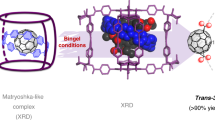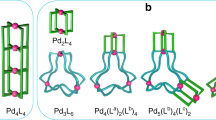Skip to main content
Thank you for visiting nature.com. You are using a browser version with limited support for CSS. To obtain
the best experience, we recommend you use a more up to date browser (or turn off compatibility mode in
Internet Explorer). In the meantime, to ensure continued support, we are displaying the site without styles
and JavaScript.
Advertisement


●
●
●
●
●
●
●
●
●
(一)nature
(二)nature chemistry
(三)articles
(四)
article
●Article
●Published:
Networked molecular cages as crystalline sponges for fullerenes and other guests
●Yasuhide Inokuma1,
●Tatsuhiko Arai1 &
●Makoto Fujita1,2
Nature Chemistry
volume 2, pages 780–783 (2010)Cite this article
11k Accesses
310 Citations
22Altmetric
Metrics details
Subjects
●Carbon nanotubes and fullerenes
●Coordination chemistry
●Inorganic chemistry
Abstract
Many molecular cages selectively bind guests in solution, but in the solid state close packing often prevents guest entry, which renders the cages inactive. We envisioned that coordination networks constructed from well-known molecular cages could transfer the richness of solution-state host–guest chemistry into the solid state. We report a crystalline coordination network generated from an infinite array of octahedral M6L4 cage subunits (M = metal, L = ligand). This coordination network is a ‘crystalline molecular sponge’ engineered on the molecular level and retains similar guest recognition properties to those found in solution. The network crystallinity is robust and thus X-ray diffraction analysis can be used to unambiguously observe single-crystal to single-crystal guest inclusion. The void spaces define alternating M12L8 and M12L24 cuboctahedral molecular cages and these large cages absorb up to 35 weight per cent of C60 or C70 by simply soaking the crystals in a toluene solution of the fullerene. When the crystals are immersed in fullerene mixtures, C70 is preferentially absorbed.
Access through your institution
Buy or subscribe
This is a preview of subscription content, access via your institution
Access options
Access through your institution
Access through your institution
Change institution
Buy or subscribe
Subscription info for Japanese customers
We have a dedicated website for our Japanese customers. Please go to natureasia.com to subscribe to this journal.
Go to natureasia.com
Buy this article
●Purchase on Springer Link
●Instant access to full article PDF
Buy now
Prices may be subject to local taxes which are calculated during checkout
Additional access options:
●
Log in
●
Learn about institutional subscriptions
●
Read our FAQs
●
Contact customer support
Figure 1: Octahedral cages as infinite networks and discrete molecular hosts.
 Figure 2: Crystal structures of TTF encapsulated by infinite and discrete M6L4 cages.
Figure 2: Crystal structures of TTF encapsulated by infinite and discrete M6L4 cages.
 Figure 3: Three distinct polyhedral molecular cages in the infinite crystalline network 1.
Figure 3: Three distinct polyhedral molecular cages in the infinite crystalline network 1.
 Figure 4: The inclusion of C60 into the crystalline network 1.
Figure 4: The inclusion of C60 into the crystalline network 1.

Similar content being viewed by others

Article
Open access
26 April 2024

Article
15 April 2021

Article
Open access
14 February 2020
References
Yaghi, O. M. et al. Reticular synthesis and the design of new materials. Nature 423, 705–714 (2003).
Article
CAS
Google Scholar
Kitagawa, S., Kitaura, R. & Noro, S. Functional porous coordination polymers. Angew. Chem. Int. Ed. 43, 2334–2375 (2004).
Article
CAS
Google Scholar
Lehn, J.-M. Supramolecular Chemistry (VCH, 1995).
Book
Google Scholar
Li, Q. et al. Docking in metal–organic frameworks. Science 325, 855–859 (2009).
Article
CAS
Google Scholar
Hof, F., Craig, S. L., Nuckolls, C. & Rebek, J. Jr Molecular encapsulation. Angew. Chem. Int. Ed. 41, 1488–1508 (2002).
3.0.CO;2-G" data-track-item_id="10.1002/1521-3773(20020503)41:9<1488::AID-ANIE1488>3.0.CO;2-G" data-track-value="article reference" data-track-action="article reference" href="https://doi.org/10.1002%2F1521-3773%2820020503%2941%3A9%3C1488%3A%3AAID-ANIE1488%3E3.0.CO%3B2-G" aria-label="Article reference 5" data-doi="10.1002/1521-3773(20020503)41:9<1488::AID-ANIE1488>3.0.CO;2-G">Article
CAS
Google Scholar
Caulder, D. L. & Raymond, K. N. Supermolecules by design. Acc. Chem. Res. 32, 975–982 (1999).
Article
CAS
Google Scholar
Yoshizawa, M., Klosterman, J. K. & Fujita, M. Functional molecular flasks: new properties and reactions within discrete, self-assembled hosts. Angew. Chem. Int. Ed. 48, 3418–3438 (2009).
Article
CAS
Google Scholar
Fujita, M. et al. Self-assembly of ten molecules into nanometre-sized organic host frameworks. Nature 378, 469–471 (1995).
Article
CAS
Google Scholar
Wang, X.-S., Ma, S., Sun, D., Parkin, S & Zhou, H.-C. A mesoporous metal–organic framework with permanent porosity. J. Am. Chem. Soc. 128, 16474–16475 (2006).
Article
CAS
Google Scholar
Abrahams, B. F., Batten, S. R., Hamit, H., Hoskins, B. F. & Robson, R. A cubic (3,4)-connected net with large cavities in solvated [Cu3(tpt)4](ClO4)3 (tpt=2,4,6-tri(4-pyridyl)-1,3,5-triazine). Angew. Chem. Int. Ed. 35, 1690–1692 (1996).
Article
CAS
Google Scholar
Ohmori, O., Kawano, M. & Fujita, M. Crystal-to-crystal guest exchange of large organic molecules within a 3D coordination network. J. Am. Chem. Soc. 126, 16292–16293 (2004).
Article
CAS
Google Scholar
Kawano, M. & Fujita, M. Direct observation of crystalline-state guest exchange in coordination networks. Coord. Chem. Rev. 251, 2592–2605 (2007).
Article
CAS
Google Scholar
Sato, S. et al. Fluorous nanodroplets structurally confined in an organopalladium sphere. Science 313, 1273–1276 (2006).
Article
CAS
Google Scholar
Chae, H. K. et al. A route to high surface area, porosity and inclusion of large molecules in crystals. Nature 427, 523–527 (2004).
Article
CAS
Google Scholar
Krätschmer, W., Lamb, L. D., Fostiropoulos, K. & Huffman, D. R. Solid C60: a new form of carbon. Nature 347, 354–358 (1990).
Article
Google Scholar
Kikuchi, K. et al. NMR characterization of isomers of C78, C82 and C84 fullerenes Nature 357, 142–145 (1992).
Article
CAS
Google Scholar
Diener, M. D. & Alford, J. M. Isolation and properties of small-bandgap fullerenes. Nature 393, 668–671 (1998).
Article
CAS
Google Scholar
Huerta, E. et al. Selective binding and easy separation of C70 by nanoscale self-assembled capsules. Angew. Chem. Int. Ed. 46, 202–205 (2007).
Article
CAS
Google Scholar
Shoji, Y., Tashiro, K. & Aida, T. Selective extraction of higher fullerenes using cyclic dimers of zinc porphyrins. J. Am. Chem. Soc. 126, 6570–6571 (2004).
Article
CAS
Google Scholar
Vandersluis, P. & Spek, A. L. Bypass: an effective method for the refinement of crystal structures containing disordered solvent regions. Acta Crystallogr. A 46, 194–201 (1990).
Article
Google Scholar
Download references
Acknowledgements
This research was supported in part by KAKENHI, Japan Society for the Promotion of Science.
Author information
Authors and Affiliations
Department of Applied Chemistry, School of Engineering, The University of Tokyo, Hongo, Bunkyo-ku, Tokyo, 113-8656, Japan
Yasuhide Inokuma, Tatsuhiko Arai & Makoto Fujita
Core Research for Evolutional Science and Technology (CREST), Japan Science and Technology Agency (JST), Hongo, Bunkyo-ku, Tokyo, 113-8656, Japan
Makoto Fujita
Authors
(一)Yasuhide Inokuma
View author publications
You can also search for this author in
PubMed Google Scholar
(二)Tatsuhiko Arai
View author publications
You can also search for this author in
PubMed Google Scholar
(三)Makoto Fujita
View author publications
You can also search for this author in
PubMed Google Scholar
Contributions
Y.I. and M.F. designed the project, analysed the results and co-wrote the manuscript. T.A. carried out the experimental work.
Corresponding author
Correspondence to
Makoto Fujita.
Ethics declarations
Competing interests
The authors declare no competing financial interests.
Supplementary information
Supplementary information (PDF 1183 kb)
Crystallographic data for 1(CIF 14 kb)
Crystallographic data for 1⊃(TTF)n (CIF 23 kb)
Crystallographic data for 1⊃(Ph2NH)n (CIF 50 kb)
Crystallographic data for 2⊃(TTF)4 (CIF 29 kb)
Rights and permissions
Reprints and permissions
About this article
Cite this article
Inokuma, Y., Arai, T. & Fujita, M. Networked molecular cages as crystalline sponges for fullerenes and other guests.
Nature Chem 2, 780–783 (2010). https://doi.org/10.1038/nchem.742
Download citation
Received:
Accepted:
Published:
Issue Date:
DOI: https://doi.org/10.1038/nchem.742
Share this article
Anyone you share the following link with will be able to read this content:
Sorry, a shareable link is not currently available for this article.
Provided by the Springer Nature SharedIt content-sharing initiative
This article is cited by
●Liangxiao Tan
●Jun-Hao Zhou
●Jiayin Yuan
Nature Communications (2022)
●Marta Mon
●Rosaria Bruno
●Emilio Pardo
Nature Communications (2020)
●Yuantao Li
●Sishuang Tang
●Michael D. Ward
Nature Communications (2019)
●Nicola Judge
●Lang Wang
●Yufeng Wang
Macromolecular Research (2018)
●Hidetsugu Shiozawa
●Bernhard C. Bayer
●Thomas Pichler
Scientific Reports (2017)
Access through your institution
Buy or subscribe
Access through your institution
Change institution
Buy or subscribe
Advertisement

●
●
●
●
●
●
●
●
●
●
●
●
●
●
●
●
●
●
●
●
●
●
●
●
●
●
●
●
●
●
Nature Chemistry (Nat. Chem.)
ISSN 1755-4349 (online)
ISSN 1755-4330 (print)
nature.com sitemap
●
●
●
●
●
●
●
●
●
●
●
●
●
●
●
●
●
●
●
●
●
●
●
●
●
●
●
●
●
●
●
●
●
●
●
kies
●
●
●
●
© 2024 Springer Nature Limited

Sign up for the Nature Briefing newsletter — what matters in science, free to your inbox daily.
Get the most important science stories of the day, free in your inbox.
Sign up for Nature Briefing







